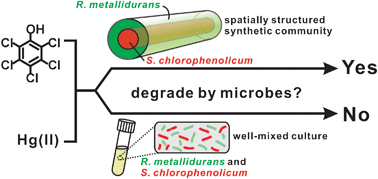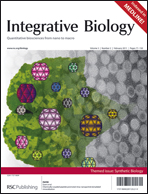Naturally occurring microbes perform a variety of useful functions, with more complex processes requiring multiple functions performed by communities of multiple microbes. Synthetic biology via genetic engineering may be used to achieve desired multiple functions, e.g. multistep chemical and biological transformations, by adding genes to a single organism, but this is sometimes not possible due to incompatible metabolic requirements or not desirable in certain applications, especially in medical or environmental applications. Achieving multiple functions by mixing microbes that have not evolved to function together may not work due to competition of microbes, or lack of interactions among microbes. In nature, microbial communities are commonly spatially structured. Here, we tested whether spatial structure can be used to create a community of microbes that can perform a function they do not perform individually or when simply mixed. We constructed a core–shell fiber with Sphingobium chlorophenolicum, a pentachlorophenol (PCP) degrader, in the core layer and Ralstonia metallidurans, a mercuric ion (Hg(II)) reducer, in the shell layer as a structured community using microfluidic laminar flow techniques. We applied a mixture of PCP and Hg(II) to either a simple well-mixed culture broth (i.e. the unstructured community) or the spatially structured core–shell fibers. We found that without spatial structure, the community was unable to degrade PCP in the presence of Hg(II) because S. chlorophenolicum is sensitive to Hg(II). In contrast, with spatial structure in a core–shell fiber system, S. chlorophenolicum in a core layer was protected by R. metallidurans deposited in a shell layer, and the community was able to completely remove both PCP and Hg(II) from a mixture. The appropriate size of the core–shell fiber was determined by the Damköhler number—the timescale of removal of Hg(II) was on the same order of the timescale of diffusion of Hg(II) through the outer layer when the shell layer was on the order of ∼200 μm. Ultimately, with the ease of a child putting together ‘Legos’ to build a complex structure, using this approach one may be able to put together microorganisms to build communities that perform functions in vitro or even in vivo, e.g. as in a “microbiome on a pill”.


 Please wait while we load your content...
Please wait while we load your content...